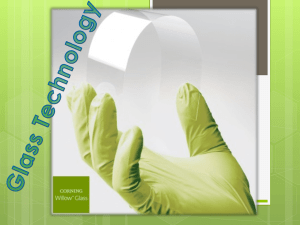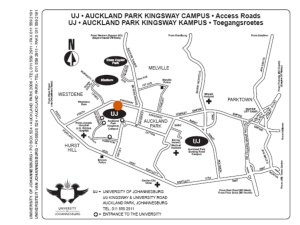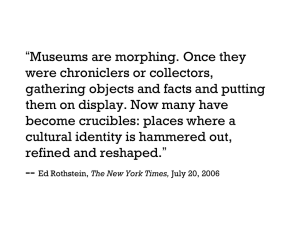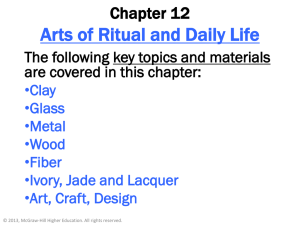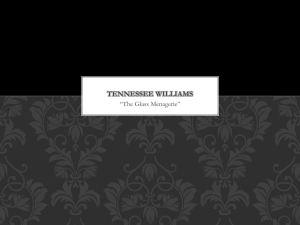Telefonata di Galluzzi - Museo del Vetro
advertisement
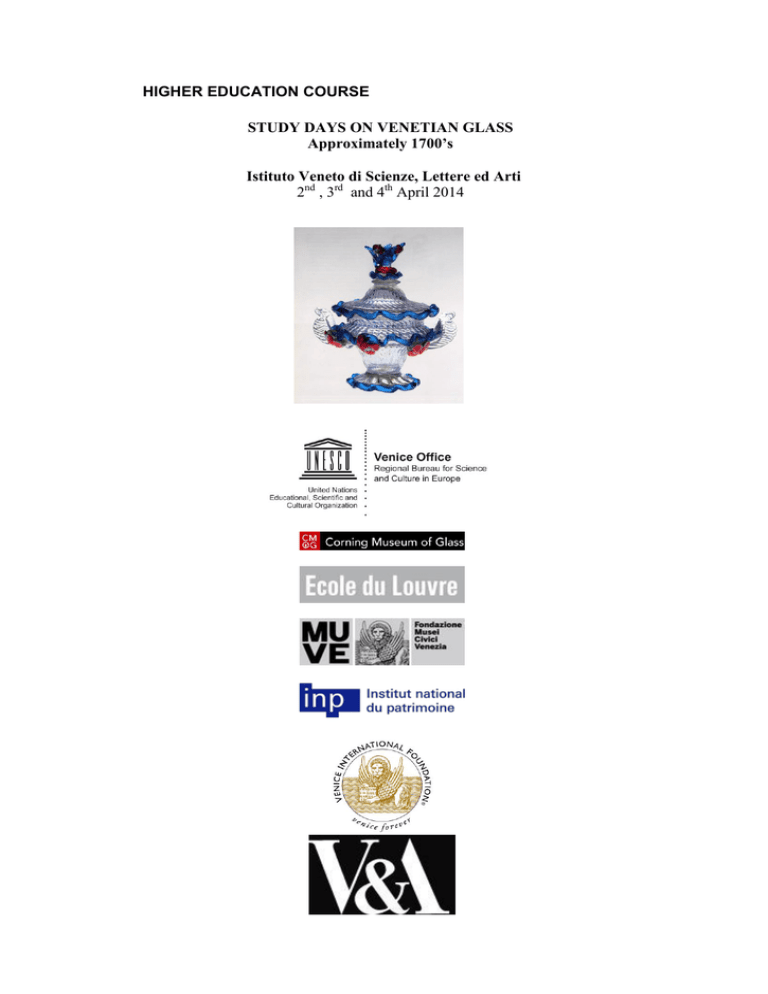
HIGHER EDUCATION COURSE STUDY DAYS ON VENETIAN GLASS Approximately 1700’s Istituto Veneto di Scienze, Lettere ed Arti 2nd , 3rd and 4th April 2014 With the support of Corning Museum of Glass Ecole du Louvre Fondazione Musei Civici Venezia Institut national du patrimoine Venice Foundation Victoria & Albert Museum With the participation of the UNESCO Regional Bureau for Science and Culture in Europe Venice (Italy) Organised with the collaboration of: AIHV - Association Internationale pour l'Historie du Verre – National Italian Committee LAMA – Laboratorio Analisi Materiali Antichi dell’Università IUAV Museo del Vetro, Fondazione Musei Civici Venezia Co-financed by the Veneto Region The “Study Days on Venetian Glass” are an opportunity for in-depth study on Venetian glass and are tuned to an audience of Museum conservators, collectors and experts. The programme includes lessons by experts who, after a general overview, will guide participants through the direct study of methods and pieces, encouraging participants to actively take part, also through presentations. Lessons and discussions will be held in English; contributions in Italian will be translated into English by the seminar curators. The topics that will be touched upon will include: General overview of the history and art history of glass; Raw materials and casting/processing techniques; Archaeometrics; Conservation and Restoration. The seminars will be completed by a tour of the Murano Glass Museum and by practical demonstrations in glassmaking studios. Scientific and Organizing Committee ROSA BAROVIER MENTASTI, Glass historian SANDRO FRANCHINI, Istituto Veneto di Scienze, Lettere ed Arti WILLIAM GUDENRATH, Corning Museum of Glass LORENZO LAZZARINI, LAMA- IUAV University of Venice SANDRO PEZZOLI, Collector LINO TAGLIAPIETRA, Artist and glass master MARCO VERITÀ, LAMA- IUAV University of Venice SECRETARY Laura Padoan ivsla@istitutoveneto.it PROGRAMME Wednesday 2nd of April Session I 9.30 a.m. ROSA BAROVIER MENTASTI, General historical and artistic overview 10.00 a.m. MARTINA FRANK, Century Venice. Decoration, glass and mirrors in Eighteenth 11.30 a.m. MARCO VERITÀ, Raw materials, casting and handling techniques Session II 2.30 p.m. ROSA BAROVIER MENTASTI, CRISTINA TONINI, Tools for studying ancient glass: paintings and graphic works, inventories WILLIAM GUDENRATH, The collection of Venetian glass given to King Fredrich IV of Denmark by the Doge during the King’s Visit to Venice in 1709 ABSTRACT: On New Year’s Day 1709, the Republic of Venice officially gifted the King over two hundred pieces of ‘the finest Venetian glass’. A small room just off the throne-room in Rosenborg Castle (Copenhagen) was fully outfitted with elaborately decorated shelves and the glass installed in 1714. Fully restored in the 1990s, the collection remains a unique ‘standard reference’ for scholars studying Venetian glass of about 1700. Exploration of typology, parallels, and variations on Rosenborg objects will be the focus of this presentation. 4.00 p.m. COMMENTS BY PARTICIPANTS REINO LIEFKES, Victoria and Albert Museum SUZANNE HIGGOTT, Wallace Collection 7.30 p.m. Reserved visit of the Basilica of San Marc Saint Mark's Basilica is a monument made unique by both its wealth of history and the magnificence of its façade and interior. In essence, it is a splendid workshop, where, through the centuries, worked great Italian and European artists. To understand the Basilica's role through the centuries, the full extent of artistic, iconographic and religious content, combined with the wealth and variety of historical influence are exhaustively presented here, within a range of searchable subject areas. Thursday 3rd of April Session III 9.30 a.m. MARCO VERITÀ, Venetian glass polychromy WILLIAM GUDENRATH e LINO TAGLIAPIETRA, Processing and decorating techniques. ABSTRACT: Close scrutiny of small technical details in historical objects can help us better characterize a style or type, and alert investigators to similarities—and differences—with comparison objects. Specially-made video segments showing reconstructed manufacturing processes will aid in better understanding Venetian glassworking techniques practiced in the early 18th century. The presentation will begin with a brief review of the findings presented at earlier Study Days symposiums (2012 and 2013) on the subjects of Venetian glass of about 1500 and 1600. COMMENTS BY PARTICIPANTS ISABELLE BIRON, Laboratoire du Centre de Recherche et de Restauration des Musées de France Introduction aux enjeux des analyses chimiques élémentaires dans l’étude des verres anciens – exemples des verres vénitiens Session IV COMMENTS BY PARTICIPANTS Reserved visit Palazzo Mocenigo The visit of Palazzo Mocenigo, in the itinerary completely renewed and expanded at the end of 2013, winds its way through twenty rooms on the first piano nobile, therefore doubling the amount of exhibition area compared to when it opened in 1985. The layout was designed by Pier Luigi Pizzi, an internationally renowned set designer, whilst palazzo furnishings and paintings were integrated with a large number of works from different sectors and deposits of the Venice Civic Museums, thanks to the painstaking, intelligent process of restoring and valorizing canvases and pastels, furnishings and glass that had never been on display before. http://www.visitmuve.it/it/musei/ Friday 4th of April Sesion V and VI 9.30 a.m. Demonstrations of workmanship in a furnace in Murano (LINO TAGLIAPIETRA and WILLIAM GUDENRATH). 2.00 p.m. Tour of the Museum of Glass in Murano The museum is housed in the ancient Palazzo dei Vescovi of Torcello. Since 1923 is part of the Musei Civici Veneziani. The collections are chronologically ordered: in addition to an archaeological section, which includes notable Roman finds from between the first and third century AD, it boasts the largest historical collection of Murano glass, featuring important pieces from between the fifteenth and twentieth century, including world-renowned masterpieces. Particularly important are the collections of Renaissance glass in the seventeenth and eighteenth centuries. During the visit, which will be directed by Rosa Barovier Mentasti and guided by the Director of the Museum Dr. Chiara Squarcina, it will be possible to have access to the deposits of the Museum to study some of the most important pieces. http://www.visitmuve.it/it/musei/ 6.00 p.m. Istituto Veneto di Scienze lettere ed Arti Final session Lecture of Maestro Pier Luigi Pizzi Saturday 5th of April Reserved visit Museum of Ca’ Rezzonico (requested booking) The Museum is housed in the palace of Ca’ Rezzonico designed by Baldassare Longhena and completed by Giorgio Massari. Since 1935 was sold to the Venice Town Council becoming the Museum of Ca’ Rezzonico. On the first floor, eleven rooms exhibit paintings, sculptures, frescoed ceilings, collections of 18th century furnishings and an important collection of Venetian chandeliers of XVIII century. The second floor opens with a long central hall typical of Venetian palaces in which there are two early works by Canaletto; the rooms dedicated to the work of Pietro Longhi and the Giandomenico Tieopolo frescoes originally on the walls of Villa Zianigo are not to be missed. The third floor contains not only the three rooms of the Ai Do San Marchi Pharmacy, but also the noteworthy collection of paintings bequeathed by Egidio Martini. http://www.visitmuve.it/it/musei/ TEACHING STAFF ROSA BAROVIER MENTASTI Descending from one of Venice’s ancient glass making families, Rosa Barovier Mentasti was awarded a degree in Ancient Literature by the University of Padua in 1973 with a thesis on antique glass. Since then, she has been dedicated to studying the history of both ancient and modern Venetian glass. In addition to many articles and publications, including Il Vetro Veneziano dal Medioevo ad oggi published in 1982, she has curated several international exhibitions of ancient and contemporary glass, including Vetri. Nel Mondo. Oggi, hosted by the Istituto Veneto di Scienze, Lettere ed Arti in Venice in 2004. MARTINA FRANK Martina Frank is currently professor for Art History at the Università Ca’ Foscari in Venice. She has previous teaching and research experiences in several European universities (Vienna, Udine, Graz, Innsbruck) and in Canada (Montréal). Author of numerous essays concerning the history of art and architecture of the Republic of Venice from the 15th to the 19th Century. Among her books a study of the patronage of the Manin family (1996), a monograph on Baldassare Longhena (2004) and Giardini dipinti (2008). Editor of Da Longhena a Selva.Un’idea di Venezia a dieci anni dalla scomparsa di Elena Bassi (2010) and Santa Maria di Nazareth. Arte e spiritualità dei Carmelitani Scalzi a Venezia. Member of the scientific boards of « Carnets du Paysage » (Ecole Nationale Supérieure du Paysage, Versailles), « 1800-MDCCC » (Università « Intrecci » (Università di Bologna). Ca’ Foscari Venezia), WILLIAM GUDENRATH As resident advisor for the Studio of the Corning Museum of Glass, he teaches introductory and advanced courses in Venetian techniques. A glassblower, scholar, lecturer and teacher of glassblowing, he is an authority on historical hot glassworking techniques from ancient Egypt through the Renaissance and has presented lectures and demonstrations throughout the world. He demonstrates techniques he believes to have been employed by glassmakers of the past and these are described in a number of books and video segments including: Chronicle: the Portland Vase, Five Thousand Year of Glass, Journey through Glass: A Tour of the Corning Museum Collection and MasterClass Series II: Introduction to Venetian Techniques, Glass Masters at Work: William Gudenrath, Glassworking Processes and Properties, Roman cameo Museum Glass in the British Museum. LINO TAGLIAPIETRA Exceptional glass master and well known world-round as glass artist. He was born in Murano and was just a young man when he first entered a glass makers shop: he became a glass maestro in the 1950’s and has worked for some of the most prestigious glass makers in the island. Since the late sixties his creativity resulted in models of great quality, both from the point of view of technique and beauty, that were a clear success on the market. He has been an independent glass artist since 1990 and is now committed to creating unique pieces that are exhibited in the most prestigious private collections and museums worldwide. In 2009, the Tacoma Art Museum dedicated a retrospective to his works with an exhibition that was then lent to other US museums. In 2011, the Istituto Veneto dedicated to him the exhibition Lino Tagliapietra, da Murano allo Studio Glass. CRISTINA TONINI With a degree in History of Art awarded by the State University of Milan under the guidance of Prof. De Vecchi, from 1989 to 2004 she acted as Conservator for the classification and the new layout of the Bagatti Valsecchi Museum in Milano. Together with Rosa Barovier she published the catalogue of the museum’s Venetian glass. She also curated the catalogues of the Medieval and Modern glass collections of the Civic Museums of Pavia, of the Pinacoteca Ambrosiana in Milano and the Pogliaghi Museum in Varese, the latter is about to be published. Other articles on Venetian and Medicaean glass have been published by Decart and the Journal Glass Studies of Corning Museum of Glass. She is part of the Board of Directors of the Italian section of the Association Internationale Histoire du Verre. She is professor of art in the Orsoline Artistic Liceo in Milano. MARCO VERITÀ Holding a degree in Chemistry, he worked for over thirty years in the Stazione Sperimentale del Vetro in Venice-Murano, performing research and assessments on glass materials, both modern and ancient, the latter for archeometric purposes and also to assess issues relating to conservation and restoration. Member of numerous international organizations, since 2009 he has been working with the Laboratory for the Assessment of Ancient Materials (LAMA) of the IUAV University of Venice. How to enrol: Applications should be sent by e-mail (ivsla@istitutoveneto.it) at the latest by 31st of January 2014. Applications should include a CV highlighting the applicant’s interest for the topic and any other previous studies in this specific field. Applications will be reviewed by the Scientific Committee that will select participants based on their qualifications and their stated motivations. The selection made will attempt to ensure the participation of candidates from different cultural backgrounds and countries of origin. Participants must be committed to take part in all courses, seminars and visits scheduled. At the end of the course, participants will receive a certificate of participation. The number of places available is limited to 30. The enrolment fee is 300 €. All expenses relating to travel to and from Venice, and food and lodgings on arrival, will be borne by participants. The organisers will bear the costs of the trip to Murano, the tour of the Glass Museum, of the Basilica of San Marc, the visit of Palazzo Mocenigo, the visit of Ca’ Rezzonico in addition to the demonstrations in Maestro Tagliapietra’s atelier. Two places will be allocated free of charge to young PhD/Research students or graduates who have applied for the course and whose CV is pertinent with the topics studied during the Study Days. One place will be allocated free of charge to a participant from the SouthEast of Europe, to be selected together with the UNESCO Bureau in Venice. Programme of the 2013 Study Days http://www.istitutoveneto.it/flex/cm/pages/ServeBLOB.php/L/IT/IDPagina/ 761
